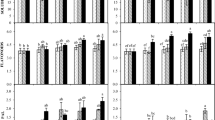Abstract
At a concentration of 17 µmol·L−1, paclobutrazol (PP), a triazole plant growth retardant, effectively reduced the elongation and increased the thickness of hypocotyls in 6-day-old Phaseolus vulgaris L. cv. Juliska seedlings, both in the light and in the dark. PP treatment did not increase the cell number in transverse sections of hypocotyls. The diameter of hypocotyls was uniform from the zone of intensive elongation along the whole hypocotyl in etiolated plants, but those grown in the light exhibited an additional lateral expansion at the base. Ethylene evolution was not reduced by PP in etiolated hypocotyls, and did not differ significantly in the elongating apical and fully grown basal zones. PP reduced the ethylene release by the growing zones in green hypocotyls, but not in the basal parts, which resulted in an increasing ethylene gradient towards the hypocotyl base. The level of 1-aminocyclopropane-1-carboxylic acid (ACC), the immediate precursor of ethylene, was much higher in retardant-treated hypocotyls than in the controls, which was due in part to the reduced malonylation. The swelling of the hypocotyl bases could be eliminated by inhibitors of ethylene biosynthesis or action, or could be induced by 10 µmol·L−1ACC in control plants in the light. None of these treatments had a significant effect on the lateral expansion of hypocotyls in etiolated seedlings. PP treatment induced a similar effect to that of white light in etiolated seedlings, and amplified the effect of light in green plants with respect to the ACC distribution, and consequently, the ethylene production in the hypocotyls of 6-day-old bean seedlings. It can be concluded that the lateral expansion of hypocotyl bases in PP-treated green plants is controlled by ethylene.
Similar content being viewed by others

References
Bandurski RS, Schulze A and Cohen DJ (1977) Photoregulation of the ratio of ester to free indole-3-acetic acid. Biochem Biophys Res Commun. 79: 1219–1223
Bernáth J, Tischner T and Ábrányi A (1982) Növénykörnyezet és Szabályozása (Control of Plant Environment, in Hungarian), pp 59. Budapest: Academic Press
Dalziel J and Lawrence DK(1984) Biochemical and biological effects of kaurene oxidase inhibitors, such as paclobutrazol. British Plant Growth Regulator Group Monograph 11: 43–57
Dicks JW (1980) Mode of action of growth retardants. British Plant Growth Regulator Group Monograph 4: 1–14
Eisinger, W (1983) Regulation of pea internode expansion by ethylene. Ann Rev Plant Physiol 34: 225–240
Foster KR, Miller FR, Childs KL and Morgan PW (1994) Genetic regulation of development in Sorghum bicolor. Plant Physiol 105: 941–948
Furuya M, Pyon CJ, Fujii T and Ito M (1969) Phytochrome action in Oryza sativa L. III. The separation of photoperceptive site and the growing zone in coleoptiles, and auxin transport as effector system. Devel Growth Diff 11: 62–76
Goodwin RH and Owens OH (1951) The effectiveness of the spectrum in Avena internode inhibition. Bull Torrey Bot Club 78: 11–21
Graebe J (1987) Gibberellin biosynthesis and control. Annu Rev Plant Physiol 38: 419–465
Grossmann K (1990) Plant growth retardants as tools in physiological research. Physiol Plant 78: 640–648
Grossmann K (1992) Plant growth retardants: Their mode of action and benefit for physiological research. In: CM Karssen, LC Van Loon and D Vreugdenhil (eds) Progress in Plant Growth Regulation, pp 788–797. Dordrecht: Kluwer Academic Publishers
Haughan PA, Burden RS, Lenton JR and Goad LJ (1989) Inhibition of celery cell growth and sterol biosynthesis by the enantiomers of paclobutrazol. Phytochemistry 28: 781–787
Iino M (1982a) Action of red light on IAA status and growth in coleoptiles of etiolated maize seedlings. Planta 156: 21–32
Iino M (1982b) Inhibitory action of red light on the growth of the maize mesocotyl: Evaluation of the auxin hypothesis. Planta 156: 388–395
Kao CH and Yang SF (1982) Light inhibition of the conversion of 1-aminocyclopropane-1-carboxylic acid to ethylene in leaves is mediated through carbon dioxide. Planta 155: 261– 266
Kende H (1993) Ethylene biosynthesis. Annu Rev Plant Physiol Plant Mol Biol 44: 283–307
Kraus TE, Murr DP, Hofstra G and Fletcher RA (1992) Regulation of ethylene synthesis in acotyledonous soybean and wheat seedlings. J Plant Growth Regul 11: 47–53
Lizada MCC and Yang SF (1979) A simple and sensitive assay for 1-aminocyclopropane-1-carboxylic acid. Anal Biochem 100: 140–146
Nagy M and Tari I (1987) Gibberellin and auxin contents and ethylene production in hypocotyls of green and etiolated bean plants treated with chlorocholine chloride. Biol Plant 29: 28– 33
Nagy M, Tari I and Bubán T (1991) IAA distribution in the hypocotyls and primary leaves of Phaseolus vulgaris L. treated with paclobutrazol in relation to their rooting capacity. Biochem Physiol Pflanzen 187: 447–451
Osborne DJ (1982) The ethylene regulation of cell growth in specific target tissues of plants. In: PF Wareing (ed) Plant Growth Substances, pp 279–290. London: Academic Press
Rademacher W (1991) Inhibitors of gibberellin biosynthesis: Applications in agriculture and horticulture. In: N Takahashi, BO Phinney and J MacMillan (eds) Gibberellins, pp 296–310. New York: Springer-Verlag
Ross JJ, Willis CL, Gaskin P and Reid JB (1992) Shoot elongation in Lathyrus elongatus L.: gibberellin levels in light and dark-grown tall and dwarf seedlings. Planta 187: 10–13
Snedecor GW and Cohran WG (1956) Statistical Methods 5th ed., pp 237–254. Ames, IA: Iowa State Univ. Press
Tari I and Nagy M (1994) Enhancement of extractable ethylene at light/dark transition in primary leaves of paclobutrazol-treated Phaseolus vulgaris seedlings. Physiol Plant 90: 353– 357
Zacarías L, Tudela D and Primo-Millo E (1990) Stimulation of ACC-dependent ethylene production in citrus leaf discs by light. Physiol Plant 80: 89–94
Author information
Authors and Affiliations
Rights and permissions
About this article
Cite this article
Tari, I., Mihalik, E. Comparison of the effects of white light and the growth retardant paclobutrazol on the ethylene production in bean hypocotyls. Plant Growth Regulation 24, 67–72 (1998). https://doi.org/10.1023/A:1005902515559
Issue Date:
DOI: https://doi.org/10.1023/A:1005902515559



